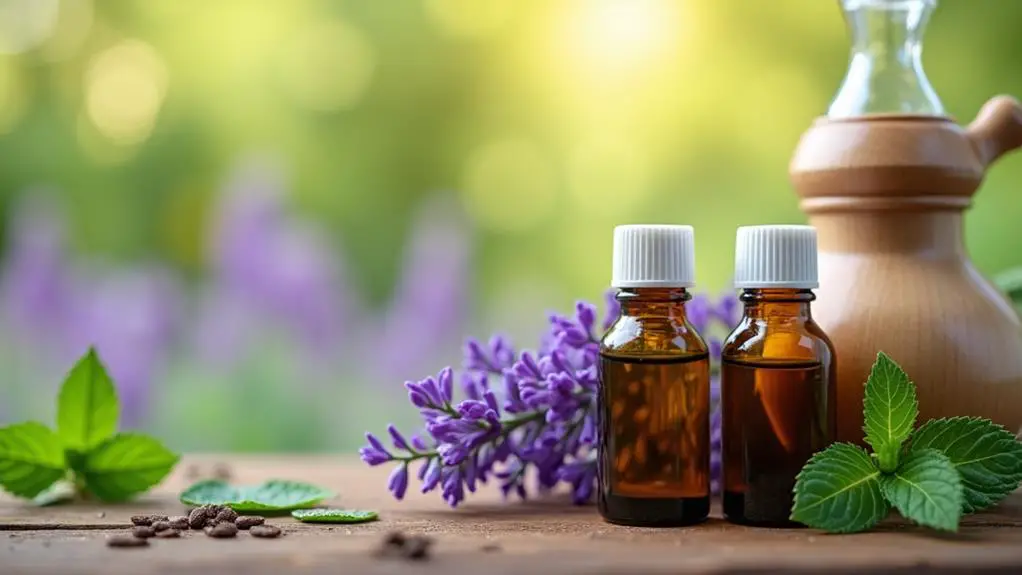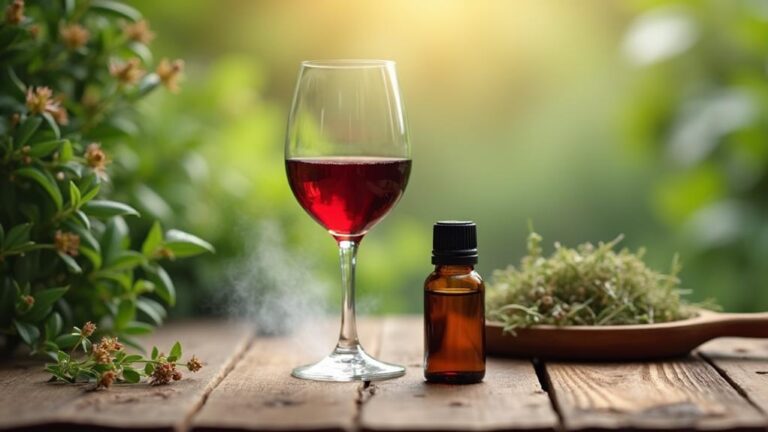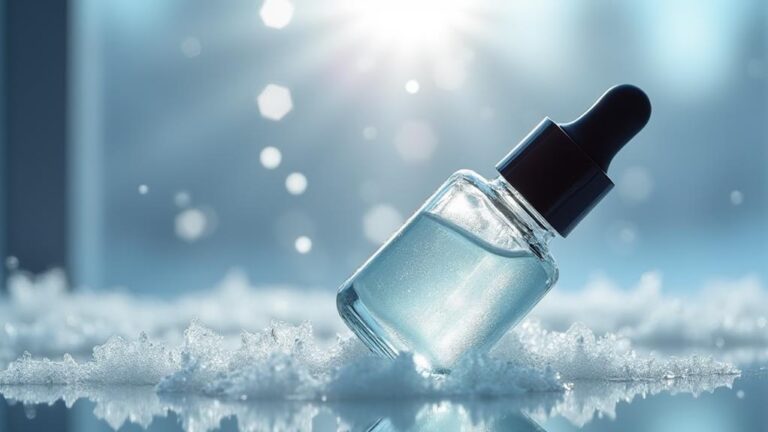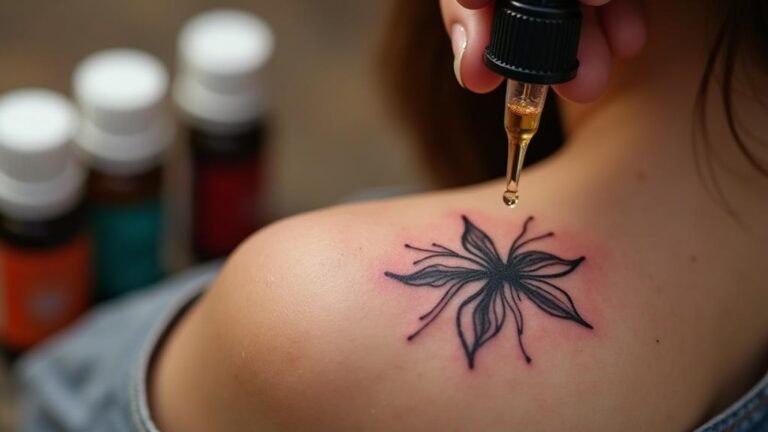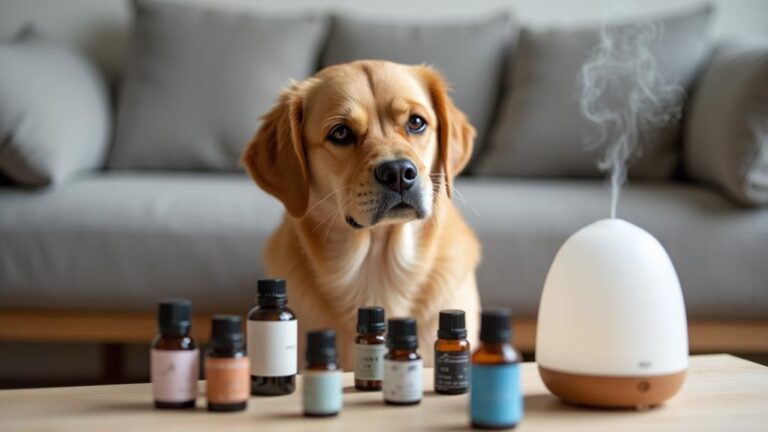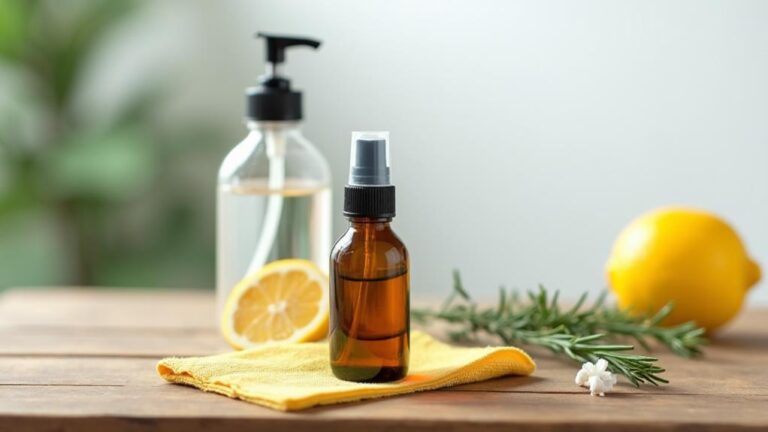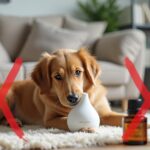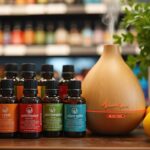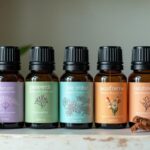When you're shopping for essential oils, you want to make sure you're getting a high-quality product that's safe and effective. But what sets a good essential oil apart from a mediocre one? It's not just about the price or the brand name – it's about the entire process, from sourcing to production. You'll want to look for oils that are sourced from organic farms, extracted using safe methods, and tested for purity. But that's just the beginning. As you explore the world of essential oils, you'll discover that the best ones share some key characteristics – but what exactly are they?
Key Takeaways
- Essential oils must be sourced from sustainable and organic farms that prioritize eco-friendly practices and transparency.
- Botanical accuracy and authenticity are crucial, as indicated by Latin naming and third-party certifications.
- Purity and concentration are tied to the absence of contaminants, verified by GC/MS testing and third-party audits.
- Extraction methods should prioritize solvent-free distillation, mechanical cold pressing, and temperature control to preserve delicate compounds.
- Transparent labeling, third-party testing, and certifications like USDA Organic or ISO 9001 guarantee the quality and therapeutic value of essential oils.
High-Quality Sourcing
When sourcing high-quality essential oils, one must consider several vital factors to guarantee authenticity and efficacy.
You should prioritize farm partnerships that adhere to sustainable and organic farming practices. This confirms that the plants used for oil extraction are grown without pesticides, herbicides, or synthetic fertilizers, resulting in a cleaner and more potent oil.
Local harvesting is also vital in preserving the quality and character of the oil.
You should look for suppliers that harvest plants at the peak time to capture their distinct aroma and therapeutic properties. This approach not only preserves the oil's efficacy but also supports local economies and reduces carbon footprint.
Additionally, you should verify the supplier's commitment to transparency and quality control.
This includes evaluating their distillation methods, oil storage, and packaging processes. A reputable supplier will provide you with detailed information about the oil's origin, composition, and production methods.
Botanical Accuracy
Most essential oils are derived from a single botanical species, but some may be blends of multiple species or even contain adulterants.
When you're looking for an essential oil that accurately represents the plant it's derived from, you need to ponder botanical accuracy. This refers to the correct identification and naming of the plant species used to produce the essential oil.
Latin naming is a pivotal aspect of botanical accuracy. You should verify that the essential oil label includes the plant's botanical name, which consists of a genus and species name.
This helps you differentiate between similar species and guarantees you're getting the desired oil. For example, Lavandula angustifolia and Lavandula latifolia are two distinct lavender species that may have different chemical compositions and uses.
Species differentiation is also imperative, as different species within the same genus can have varying properties and effects.
You should research the specific species used to produce the essential oil and understand its unique characteristics. By doing so, you can make informed decisions about the essential oil you choose and guarantee it meets your needs.
Accurate botanical identification is essential for safe and effective use.
Purity and Concentration
The quality of an essential oil is directly tied to its purity and concentration.
When you assess the purity of an essential oil, you're basically evaluating the absence of contaminants and adulterants. You want to guarantee that the oil hasn't been diluted or altered with synthetic chemicals, which can affect its efficacy and safety.
Oil authentication is vital in this regard, as it helps verify the oil's botanical identity and certifies it meets the required standards.
Concentration is another vital aspect of essential oil quality. You should look for oils that have a promised concentration of their active compounds.
Batch variation can occur due to factors like climate, soil quality, and harvesting methods. Reputable manufacturers will provide batch-specific information, including the concentration of active compounds, to certify consistency and quality.
When evaluating the purity and concentration of an essential oil, you should also check the product label for certifications like GC/MS testing or third-party audits.
These certifications indicate that the oil has been tested for purity and quality, giving you confidence in your purchase.
Safe Extraction Methods
When evaluating safe extraction methods for essential oils, you'll want to ponder two primary techniques:
Solvent-free distillation involves heating plant material to release the essential oil, which is then collected and separated through condensation.
Mechanical cold pressing, on the other hand, uses pressure to extract the oil from plant material, typically citrus peels.
Solvent-Free Distillation
Solvent-free distillation methods prioritize essential oil quality and safety by eliminating harsh chemicals from the extraction process.
When you look for high-quality essential oils, consider those that use solvent-free distillation methods, which guarantee the oil's natural chemical composition is preserved.
This method involves heating the plant material to release its volatile compounds, which then condense and separate from the water, resulting in a concentrated essential oil.
You should also consider the distillation methods used, as different techniques can affect the final product's quality.
Look for distillation methods that involve temperature control, as this allows for a more precise extraction process.
Temperature control helps prevent overheating, which can damage the plant material and result in a lower-quality oil.
Proper temperature control also enables the distiller to target specific chemical compounds, resulting in a more consistent and effective essential oil.
Mechanical Cold Pressing
Essential oil extraction via mechanical cold pressing is a safe, chemical-free method that's primarily used for citrus essential oils, such as those from lemons, oranges, and grapefruits.
This process involves using a mechanical press to extract the oil from the citrus peel, resulting in a high-quality essential oil. When you're looking for a good essential oil, verifying the extraction method used is crucial, as cold pressing can profoundly impact the oil quality.
Cold pressing is a preferred method for citrus essential oils because it preserves the delicate compounds found in the peel.
This process doesn't involve heat, which can damage or destroy these compounds, resulting in a lower-quality oil. By using cold pressing, you can be confident that the essential oil you're getting is of high quality and free from chemical contaminants.
As you evaluate the characteristics of a good essential oil, weigh the extraction method used and look for cold pressing as a preferred method, especially for citrus essential oils. This will guarantee that you're getting a high-quality oil that meets your standards.
Third-Party Testing
When purchasing essential oils, you'll want to verify their authenticity of purity, which often involves third-party testing.
Third-party labs test essential oils using methods such as gas chromatography (GC) and mass spectrometry (MS) to analyze their chemical composition.
Certification bodies, such as the International Organization for Standardization (ISO), establish standards for third-party testing and certification, ensuring the quality and purity of essential oils.
Authentication of Purity
While purchasing essential oils, verifying the product's purity is paramount to guarantee its safety and efficacy.
As you navigate the market, it's pivotal to be aware that oil fraud is a significant concern. Unscrupulous suppliers may adulterate essential oils with cheaper alternatives or synthetic chemicals, compromising their quality and potentially harming your health.
To mitigate this risk, third-party testing is essential. Reputable manufacturers will often partner with independent labs to validate the purity and authenticity of their products.
This process involves collecting random samples from the supply chain and subjecting them to rigorous testing. By doing so, you can confirm that the essential oils you purchase are free from contaminants and adulterants.
When evaluating a manufacturer's claims, look for evidence of third-party testing and authentication.
Check if they provide batch-specific reports, which indicate that the testing was conducted on the exact product you're purchasing. Additionally, verify the lab's credentials and reputation to confirm that the testing is credible and unbiased.
Lab Testing Methods
To verify the authenticity of essential oils, several lab testing methods are employed during third-party testing.
These methods help you evaluate the quality, purity, and composition of the essential oil. One of the primary methods used is Gas Chromatography (GC), which separates and analyzes the individual components of the essential oil.
This technique provides a detailed breakdown of the oil's chemical composition, allowing you to identify the presence of specific compounds.
Another vital method used in conjunction with GC is Mass Spectrometry (MS). This technique measures the mass-to-charge ratio of the individual components, providing a more detailed analysis of the oil's composition.
By combining GC and MS, you can obtain an exhaustive profile of the essential oil, including its constituent compounds and their concentrations.
When evaluating the lab testing methods used by an essential oil manufacturer, look for third-party testing that employs GC and MS.
This confirms that the oil has been thoroughly analyzed and its composition verified. By doing so, you can make informed decisions about the quality and authenticity of the essential oil.
Certification Body Standards
Your analysis of an essential oil's quality doesn't stop at lab testing methods – it also involves verifying compliance with third-party certification body standards.
These standards guarantee that essential oil producers adhere to industry standards, which are often more stringent than government regulations. Look for certifications from reputable bodies like the International Organization for Standardization (ISO) or the National Association for Holistic Aromatherapy (NAHA).
When evaluating an essential oil's certification, consider the scope of the certification body's standards.
Do they cover aspects like sourcing, production, and packaging? Are the standards regularly reviewed and updated to reflect the latest scientific research and regulatory oversight?
A robust certification program will provide transparency into the essential oil's production process and guarantee that it meets or exceeds industry standards.
Transparent Labeling
Transparent labeling is pivotal when selecting essential oils, as it allows you to make informed decisions about the products you use.
A transparent label claim should clearly state the essential oil's botanical name, country of origin, and plant part used. This information enables you to verify the oil's authenticity and quality.
Ingredient disclosure is another key aspect of transparent labeling.
You should look for labels that explicitly list the essential oil's constituents, including their concentrations. This information is particularly important if you have allergies or sensitivities. Additionally, some essential oils may be blended with other oils or additives, so it's imperative to check the label for any potential allergens.
When evaluating an essential oil's label, check for third-party testing data, such as gas chromatography (GC) or mass spectrometry (MS) reports.
These reports provide an objective analysis of the oil's chemical composition, allowing you to verify the label claim. By choosing essential oils with transparent labeling, you can guarantee that you're using high-quality products that meet your needs and preferences.
Therapeutic Grade
Essential oil manufacturers often tout their products as "therapeutic grade," but this claim is largely unregulated. As a consumer, it is crucial to understand the implications of this label. The term "therapeutic grade" is not recognized by any governing body, and its use is not subject to strict guidelines.
| Industry Standard | Description | Compliance |
|---|---|---|
| GC/MS Testing | Validates the oil's chemical composition is accurate | Voluntary |
| Organic Certification | Verifies the oil is free of pesticides and synthetic chemicals | Mandatory for certified products |
| Third-Party Audits | Regular inspections to guarantee quality and purity | Voluntary |
| ISO Standards | Global standards for essential oil quality and safety | Voluntary |
| Good Manufacturing Practices (GMPs) | Guarantees proper manufacturing and handling procedures | Mandatory for FDA-regulated products |
When evaluating an essential oil's therapeutic grade, consider the manufacturer's adherence to industry standards and oil regulations. Look for third-party certifications, such as USDA Organic or ISO 9001, which indicate a level of quality control. Keep in mind that the absence of these certifications does not necessarily mean the oil is of poor quality, but rather that the manufacturer has chosen not to invest in these processes.
Aromatic Integrity
When sourcing an essential oil, considering its aromatic integrity is crucial, as it directly impacts the oil's therapeutic properties and fragrance profile.
Aromatic integrity refers to the oil's ability to retain its natural scent, fragrance profile, and scent longevity. You should look for essential oils that have been extracted using methods that preserve the delicate chemical compounds responsible for their aroma.
Aromatic integrity is often compromised during the extraction, processing, and storage stages. Factors such as heat, light, and oxygen can cause the essential oil to degrade, resulting in a loss of its therapeutic properties and fragrance profile.
When an essential oil has poor aromatic integrity, its scent may not last long, and its therapeutic benefits may be diminished.
To certify the aromatic integrity of an essential oil, you should check the label for information on the extraction method, processing techniques, and storage conditions.
Reputable manufacturers will provide this information to guarantee the quality of their essential oils. By choosing an essential oil with good aromatic integrity, you can enjoy its fragrance profile and therapeutic benefits for a longer period.
Sustainable Production
When you consider the environmental impact of essential oil production, you'll likely assess the methods used to cultivate, harvest, and process the plants that yield these oils.
You'll also examine the responsible sourcing practices that guarantee the long-term sustainability of these plant resources.
Environmental Impact
The cultivation, harvesting, and processing of plants for essential oil production can substantially impact the environment.
As you consider the environmental impact of essential oils, look for producers who prioritize climate responsibility and eco-friendliness. This includes using sustainable farming practices, such as permaculture or regenerative agriculture, which promote soil health and biodiversity.
You should also check if the producer uses renewable energy sources, like solar or wind power, to reduce their carbon footprint.
Additionally, consider the water usage and waste management practices of the producer. Eco-friendly producers often implement efficient irrigation systems and minimize waste by using plant by-products in other products.
When researching essential oil producers, look for certifications like Organic or Fair Trade, which promote environmentally friendly practices.
You can also check if the producer has implemented reforestation programs or conservation efforts to offset their environmental impact.
Responsible Sourcing
Producers prioritizing sustainable production practices are more likely to guarantee responsible sourcing.
When you're looking for a good essential oil, you want to confirm it's sourced responsibly. This means checking if the producer has adopted fair trade practices and partnered with local farmers.
Fair trade practices confirm that farmers receive fair prices for their crops, improving their livelihoods. Local farmer partnerships also promote community development and preserve traditional farming methods.
Responsible sourcing involves considering the social and environmental impact of the production process.
You want to know if the producer has implemented measures to minimize waste, reduce water consumption, and prevent soil erosion.
By choosing an essential oil from a producer that prioritizes responsible sourcing, you're supporting sustainable agriculture and contributing to a more equitable supply chain.
When evaluating essential oils, look for certifications like Fair Trade or Organic, which indicate adherence to sustainable production practices.
Reasonable Price Range
Determining a reasonable price range for essential oils involves researching the market and examining several factors, including the oil's quality, rarity, and production costs.
When evaluating the price of an essential oil, you should weigh market trends and the potential for price variability.
Some key factors to ponder when evaluating the price of an essential oil:
- Quality of the oil: High-quality oils that are extracted using traditional methods or from rare plants may be more expensive than lower-quality oils.
- Rarity of the plant: Oils extracted from plants that are difficult to cultivate or are in high demand may be more expensive than oils from more common plants.
- Production costs: Factors such as labor costs, equipment costs, and transportation costs can impact the final price of the oil.
- Certifications and regulations: Oils that are certified organic or meet specific regulations may be more expensive than non-certified oils.
Frequently Asked Questions
Can Essential Oils Be Used on Pets and Animals?
When using essential oils around pets, you must prioritize pet safety and consider animal testing results. Always dilute oils, consult a vet, and choose pet-friendly oils to avoid adverse reactions and guarantee your pet's well-being.
How Long Do Essential Oils Typically Last When Stored?
Freshly fetched from the fridge, you'll find essential oils typically last 1-3 years when stored properly. Shelf life factors and storage conditions, like temperature and light exposure, markedly impact the oil's potency and duration.
Can I Ingest Essential Oils for Health Benefits?
Ingesting essential oils for health benefits can be risky; you must guarantee the oil quality is suitable for internal use, as some oils can be toxic or cause adverse reactions, even at small doses.
Are Essential Oils Safe to Use During Pregnancy?
When pregnant, you should exercise caution with essential oils due to potential risks. Pregnancy precautions are vital to guarantee prenatal safety, as some oils can stimulate the uterus or affect the fetus, so always consult a healthcare professional before use.
Can I Use Essential Oils on Open Wounds or Cuts?
When treating open wounds or cuts, you shouldn't use essential oils without proper wound cleaning protocols. It's also vital to perform skin sensitivity tests first to avoid further irritation or infection complications.
Conclusion
Research confirms that a good essential oil is more than just a pleasant scent. In reality, its therapeutic potential relies heavily on its quality. By choosing an oil that meets the outlined criteria, you're not only ensuring your safety but also its effectiveness. The truth is, a cheap essential oil can be costly in the long run, whereas a high-quality one, despite the higher price, can provide long-lasting benefits and ideal results.


